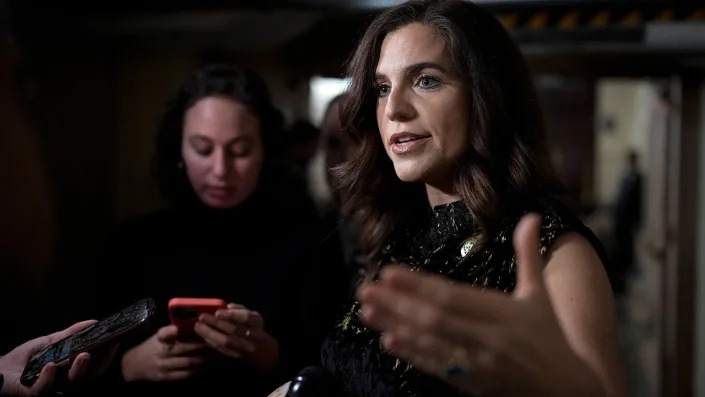Booting Rep. Omar off House Foreign Affairs Committee is 'cancel culture,' says GOP Rep. Mace
Rep. Nancy Mace, R-S.C., said Friday it would be hypocritical for Republicans to boot Rep. Ilhan Omar D-Minn., from the House Foreign Affairs Committee over anti-Semitic comments, and said doing so amounts to a form of "cancel culture."
HER PRO PALESTINE /PRO BDS/ ANTI-ISLAMAPHOBIA COMMENTS ARE NOT ANTI-SEMITIC
"There's a First Amendment in this country. We don't have to agree with everything that members say," Mace said Friday when Fox News asked if she supported Speaker Kevin McCarthy's vow to block Omar from the committee.
"I think we have to be very careful about what we are as a constitutional republic," she said. "I am not a fan of Ilhan Omar. She's an anti-Semite. She's a bigot. She's a racist. She's a socialist. But that doesn't mean that we cancel people in this country. Republicans don't stand for cancel culture. And that's essentially what this is."
Mace indicate that there were a "handful" of Republicans who are aligned in her thinking.
"I think it sets a very dangerous precedent. And you know, there's so much anti-Semitism in this country. We should be condemning it right and left as we always have, but there's also the First Amendment right to do that," she said.
ILHAN OMAR SAYS MCCARTHY LEAVING HER OFF AFRICA SUBCOMMITTEE IS 'RACIST, XENOPHOBIC'
"We're all talking about the Twitter files and conservatives being censored, you know, it's, it's, it seems pretty hypocritical if you ask me," Mace added.
Mace said that a resolution to remove Omar was yet to be circulated, and she would wait to read it before making her final decision.
"So I'm going to read the resolution. We haven't seen it. I'm going to read it before I make that final decision next week. But we've been asking for it, and it hasn't been released to public yet," she said.
Ilhan Omar says McCarthy leaving her off Africa subcommittee is 'racist, xenophobic'
Lawrence Richard
Thu, January 26, 2023
In a new statement, Rep. Ilhan Omar is now accusing House Speaker Kevin McCarthy of being "racist" and "xenophobic" for removing her from the House Foreign Affairs Committee.
Omar, a member of the Subcommittee on Africa, Global Health, and Global Human Rights, defended her position in a tweet saying she is "the only African-born" member.
"As the only African born, not being on the Africa subcommittee is not just an elimination of a unique voice but an elimination of all the voices that have never been heard on a committee on the continent," Omar wrote.
She added: "It’s racist, xenophobic and discriminatory."
SCHIFF, SWALWELL, OMAR RESPOND AFTER SPEAKER MCCARTHY KEEPS THEM OFF COMMITTEES: 'POLITICAL VENGEANCE'

A split photo of House Speaker Kevin McCarthy, R-Calif., and Rep. Ilhan Omar, D-Minn.
Omar echoed these remarks during an appearance Sunday on MSNBC's "Yasmin Vossoughian Reports."
"I think it would be hypocritic [sic] for him to remove, you know, the first African born on subcommittee on Africa on the Foreign Affairs Committee, where I’ve had the opportunity to not only represent my constituents but the voice of so many people who have never had a voice on the Foreign Affairs Committee," Omar said.
Omar has previously described McCarthy's decision as a political stunt, a blow to the integrity of the democratic institution and a threat to national security.
HOUSE DEM LEADER PREDICTS 'BIPARTISAN' SUPPORT TO KEEP ILHAN OMAR ON FOREIGN AFFAIRS COMMITTEE
McCarthy has said he is removing Omar from the position as she has upset many of her colleagues in the past with controversial anti-Israel statements that highlighted antisemitic tropes.
She once said, "It's all about the Benjamins, baby" to explain why McCarthy criticized her for opposing the Jewish country. She also sparked backlash for a remark comparing the U.S. and Israel to Hamas and the Taliban.
McCarthy, as Speaker, has the authority to approve committee appointments offered by Minority Leader Hakeem Jeffries.

Rep. Ilhan Omar, D-MN, outside the U.S. Capitol on January 26, 2023, in Washington, DC.
Republican members could offer a vote to keep Omar on the committee, and at least two Republicans have expressed support to keep her position.
Rep. Victoria Spartz, R-Ind., and Nancy Mace, R-SC., said they oppose removing her from the committee.
ILHAN OMAR'S LONG HISTORY OF CONTROVERSIAL STATEMENTS
In addition to Omar, McCarthy has rejected the appointments of Reps. Adam Schiff and Eric Swalwell, both Democrats from California, to the House Intelligence Committee.
"Kevin McCarthy just kicked me and @RepSwalwell off the Intelligence Committee," Schiff tweeted Tuesday. "This is petty, political payback for investigating Donald Trump."

From left, Reps. Adam Schiff, D-Calif., Ilhan Omar, D-Minn., and Eric Swalwell, D-Calif., conduct a news conference on being removed from committees assignments, in the Capitol Visitor Center on Wednesday, January 25, 2023.

Reps. Eric Swalwell, D-Calif., center, Adam Schiff, D-Calif., and Ilhan Omar, D-Minn., conduct a news conference on being removed from committees assignments, in the Capitol Visitor Center on Wednesday, January 25, 2023.
"If he thinks this will stop me, he will soon find out just how wrong he is. I will always defend our democracy," the Democrat added.
The Africa, Global Health, and Global Human Rights Subcommittee previously included Reps. Karen Bass, D-Calif., who was the Chairwoman in the 117th Congress, Christopher Smith, R-NJ., Darrell Issa, R-Calif., Greg Steube, R-Fla., Dean Phillips, D-Minn., Ami Bera, D-Calif., Young Kim, R-Calif., Ronny Jackson, R-TX., Sara Jacobs, D-Calif., and others.
McCarthy might have a math problem in blocking Omar from panel

Mychael Schnell
Thu, January 26, 2023
Speaker Kevin McCarthy’s (R-Calif.) vow to block Rep. Ilhan Omar (D-Minn.) from sitting on the House Foreign Affairs Committee has hit an early snag: He may not have the votes to do it.
Omar, one of three Muslims in Congress, has been a controversial figure on Capitol Hill for her sharp criticisms of the Israeli government and its human rights record. Republicans have said she’s crossed a line into antisemitism, and McCarthy’s case for booting her from Foreign Affairs rests on that accusation.
But McCarthy has a math problem to solve, one that could prove an early test of his ability to keep his narrow majority united and fulfill a long-running vow.
Democrats are rallying behind Omar, which could force GOP leaders to rely entirely on their own members if they’re to succeed.
“Thee’s already two Republicans that have indicated that they won’t vote to put her off, and I think others will come aboard also,” said Rep. Gregory Meeks (N.Y.), the senior Democrat on the Foreign Affairs Committee, who is lobbying Republicans on Omar’s behalf.
“So I don’t think it’s going to be a simple vote. I think that she has a good chance of staying.”
Rep. Victoria Spartz (R-Ind.) said this week she’ll oppose the measure, calling McCarthy’s move “unprecedented” while citing her opposition to Democrats’ successful removal of GOP Reps. Marjorie Taylor Greene (Ga.) and Paul Gosar (Ariz.) from committees in 2021.
“Two wrongs do not make a right,” she said in a statement. “As I spoke against it on the House floor two years ago, I will not support this charade again.”
Rep. Nancy Mace (R-S.C.) has been similarly cool to the concept, also pointing to her criticism of the Greene and Gosar evictions under Democratic rule.
“I’m not going to be a hypocrite just because Republicans are in the majority now,” she told reporters Wednesday morning. “It’s not been a precedent in Congress to kick people off of their committees because of things that they say, even if you vehemently disagree with those things.”
Still, Mace said she’s withholding final judgment until the final resolution is released.
Adding to the mathematical headache, Rep. Greg Steube (R-Fla.) said he will be “sidelined in Sarasota for several weeks” after falling 25 feet from a ladder on his property — denying Republicans an easy “yes” vote if the resolution hits the floor soon.
A wild card in the debate remains whether Democrats would vote unanimously to support Omar. The overwhelming majority are expected to do so, putting pressure on McCarthy to rally his own troops. But several Democrats aren’t showing their hands, including Reps. Josh Gottheimer (N.J.) and Jared Moskowitz (Fla.), two Jewish lawmakers who represent large Jewish constituencies.
Asked Wednesday if every Democrat would support Omar, Democratic Caucus Chairman Pete Aguilar (Calif.) was coy, saying only that “it’s going to be a bipartisan vote to keep her on the committee.”
Omar hasn’t officially been recommended for the committee yet and a House vote has not been set.
For months, McCarthy has signaled he would block three Democrats from serving on certain committees should he win the gavel: Omar on Foreign Affairs, and Reps. Adam Schiff (Calif.) and Eric Swalwell (Calif.) on the House Intelligence Committee.
That push began in 2021 after Democrats — and some Republicans — voted to remove Greene and Gosar from their committees as punishment for promoting violence against Democrats on social media.
McCarthy began his house-cleaning effort on Tuesday night when he blocked Schiff and Swalwell from the Intelligence panel, accusing the pair of abusing their positions at risk of national security. Because of the special rules governing the Intel panel, he was able to do so unilaterally.
The effort to block Omar from Foreign Affairs won’t be quite as easy, since it requires a vote of the full House.
Republicans are focusing on past comments from Omar that have been accused of being antisemitic and anti-Israel. In 2019, for instance, she tweeted that lawmaker support for Israel is “all about the Benjamins, baby” — a remark that sparked immediate condemnation from Democratic leaders and forced Omar to issue an apology.
More recently, she received widespread criticism for equating the U.S. and Israel with the Taliban and Hamas when it comes to human rights abuses.
“It would be odd to me that members would not support [the removal resolution] based upon her comments against Israel,” McCarthy said Tuesday night.
But Omar is defending her right to sit on the panel, arguing that she has already paid the price for her comments.
“I have addressed it, I’ve apologized,” the congresswoman told reporters on Wednesday.
As the debate evolves, Democrats are seeking to distinguish between their decision to remove Greene and Gosar in 2021, and the Republicans’ targeting of Omar and other Democrats, arguing that the violence promoted by the GOP lawmakers put them in a different league.
“Suggesting violence against other members, your colleagues, is a much more serious offense,” said Rep. Ami Bera (D-Calif.). “I think we start to go down a dangerous path when you start to remove members because you disagree with their policies.”
Democrats are also pointing to a separate episode in the last Congress involving Rep. Lauren Boebert (R-Colo.), who told a crowd in her district that sharing an elevator with Omar was alarming — until she saw that Omar “doesn’t have a backpack.”
The implication was that Omar must be a suicide bomber because of her faith, and Democrats demanded that McCarthy condemn the remarks — something he refused to do.
“Nothing. Not a word. Not a peep,” Meeks said.
Then-Speaker Nancy Pelosi (D-Calif.) also resisted efforts to have Boebert removed from her committees, infuriating liberals at the time.
“That’s assuming that all Muslims are terrorists, right?” Rep. Rashida Tlaib (D-Mich.), another Muslim lawmaker, said Wednesday. “All of this is so incredibly frustrating.”
McCarthy and Rep. Michael McCaul (R-Texas), the Foreign Affairs chairman, made their case for blocking Omar during a closed-door meeting with the House GOP conference Wednesday morning, when McCaul highlighted a number of Omar’s statements that have been cited as antisemitic.
“They went through ‘em,” Rep. Don Bacon (R-Neb.), who was initially undecided but opted to support the effort following the presentation, said afterward. “Because we need to remind people, this is what she said in the past.”
Other Republicans have remained mum on how they will vote, including Rep. Brian Fitzpatrick (R-Pa.), one of 11 Republicans who voted to boot Greene from her committees.
“We’ve got to have consistent rules that apply to everybody,” Fitzpatrick said Wednesday, adding that “we haven’t even seen anything yet.”
Meanwhile, Omar’s allies say they’re eager for the battle to reach the floor to get everyone on the record.
“I’m fully supportive of taking a vote — I think it’s important,” said Tlaib. “Because if we’re going to continue doing this over and over again, I want to see where everybody stands.”
The Hill.














